Among the many exhibitions that were cancelled because of Covid-19 last year was one on the Swiss-born artist Angelica Kauffman (1741–1807), which had been due to open at the Royal Academy of Arts in June. The exhibition would have represented a belated recognition by the Royal Academy of Kauffman, who was one of its two female founder members in 1768 (the other was the less well-known Mary Moser). As feminist art historians have often noted, both women feature in Johann Zoffany’s group portrait from 1771–72 of the academicians contemplating the male nude but, for reasons of decorum, they do so only as a pair of painted likenesses hanging on the wall. At the time, no woman was permitted to attend the life class of the academy where students learned the drawing skills required to practise the ‘noble’ genre of history painting. What makes Kauffman remarkable is that, despite this handicap, she forged a successful career and achieved international renown not only as a sought-after portraitist but also as a committed history painter.
Scholarly interest in Kauffman has grown in recent decades, helped by the efforts of art historians such as the late Angela Rosenthal, author of a fine monograph on the artist published in 2006, and Bettina Baumgärtel, who is preparing a catalogue raisonné. Baumgärtel curated the exhibition that was due to travel from the Kunstpalast in Düsseldorf, where she is head of the paintings collection, to the Royal Academy. The cancellation meant that a British audience was deprived of the first opportunity to see Kauffman’s work on any scale since 1992, when she was the subject of an exhibition at Brighton Museum and Art Gallery. It is all the more regrettable since comparatively few of her paintings are readily available to public view in Britain, despite the fact she lived in London for 15 years, from 1766 until 1781 (she spent the rest of her career in Rome). The majority of Kauffman’s works are located in country houses, such as Saltram in Devon, a National Trust property that holds 11 of her pictures, and so require dedication (and a car) to see them.
The Kauffman exhibition had been due to overlap in London with the Artemisia Gentileschi show at the National Gallery, and I’d hoped that this coincidence might stimulate a wider debate about women artists of earlier centuries. I had hoped too that it would draw attention to Kauffman in a way that the Royal Academy exhibition might not have done on its own. Like Gentileschi, Kauffman was the daughter of an artist who provided her initial training. Although her life story is much less dramatic, Kauffman encountered challenges of her own; in 1767, she was tricked into marriage by a bigamous fake count, a scandal that could easily have scuppered her career. If anything, as Zoffany’s group portrait reveals, the artistic and social constraints that women artists faced during Kauffman’s lifetime made it more difficult for them to create ambitious figure paintings than it had been 150 years earlier. At the same time, however, the establishment of regular public art exhibitions opened up new opportunities for women.
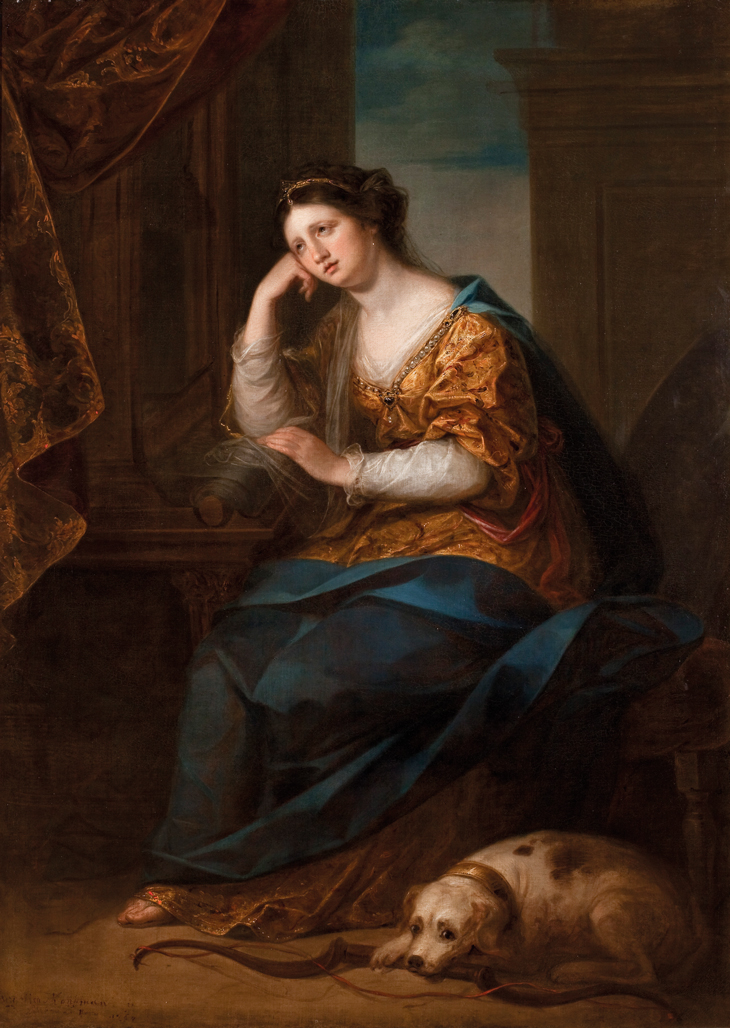
Penelope at Her Loom (1764), Angelica Kauffman. Brighton and Hove Museums and Art Galleries. Photo: Royal Pavilion and Museums, Brighton and Hove
My own fascination with Kauffman has to do with the wonderfully adroit way in which the artist negotiated this situation. She circumvented restrictions on women studying the male nude by producing female-centred compositions, often on subjects from ancient literary sources such as the Odyssey that had seldom (if ever) been painted before, as with Penelope at Her Loom (1764). In her self-portraits and other works, Kauffman appropriated historical, mythological and allegorical identities such as Sappho and even Hercules in order to lay claim to creative authority on behalf both of herself and other women. My interest in Kauffman also relates to my research on the influence of the 18th-century ‘cult of sensibility’ (or, as I prefer to call it, sentimentalism) on visual art. Aspects of her work that might strike a modern viewer as contrived or even ridiculous, such as the impossibly ethereal physiques of her figures, would then have generally been understood to signify a high-minded commitment to sentimental ideals. Most of Kauffman’s paintings were known to me only in reproduction, which is why, after the end of the first lockdown, I made the trip to Düsseldorf where the exhibition reopened in June for an extended run.
The thrill of seeing Kauffman’s work in person was reinforced by the presence of some 25 paintings that were only ever going to be exhibited at the Kunstpalast. They included a ravishing portrait of a young woman, newly identified as Catherina Odescalchi, Duchessa di Bracciano. For a British visitor, it was a rare treat to see many unfamiliar works from collections across Europe: from Zurich, for example, came Kauffman’s portrait of the great scholar and antiquarian Johann Joachim Winckelmann, which made the artist’s name when she was only 22. It was also a chance to see numerous paintings from British collections that are not normally on public display; Cleopatra Decorating the Tomb of Mark Anthony from Burghley House in Cambridgeshire stood out for its monumental simplicity and solemn pathos, which prompted comparison with the later neoclassicism of Jacques-Louis David. It is sadly likely, however, that only a handful of British visitors made it to Düsseldorf, not least because anyone who travelled there by train through Belgium, as I did, had to quarantine on their return home.
Those fortunate enough to have seen the show will have been left in no doubt as to just how successful Kauffman was during her lifetime. The first room in the exhibition highlighted the words of the Danish ambassador in London, who in 1781 quoted an engraver as saying: ‘the whole world is angelicamad’. It also featured a mock-up of an 18th-century print room as a backdrop for a display of engravings after Kauffman. A glass case of ceramics decorated with designs after Kauffman provided further evidence of the enthusiastic response her compositions elicited from contemporaries. Another room centred on the four ceiling paintings that Kauffman was commissioned to paint for the lecture room at the Royal Academy, the only such works known to have been painted by a woman during the 18th century. Each depicting a female personification of a different aspect of the history painter’s art – invention, design, composition and colour – they seem to offer a manifesto for Kauffman’s own highly ambitious practice.
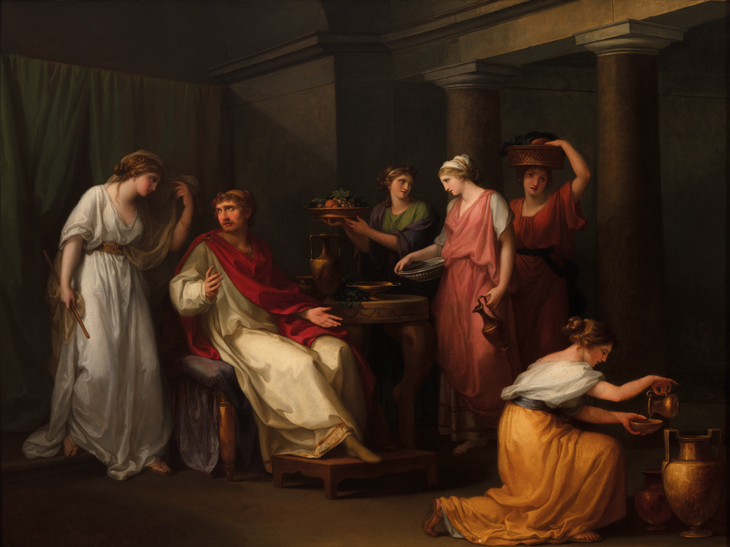
Ulysses on the Island of Circe (1793), Angelica Kauffman. Barrett Collection, University of Texas at Dallas
What struck me most, however, was the way in which Kauffman’s personal ambition goes hand in hand with a sense of female solidarity. She consistently foregrounds the achievements and the virtues of her own sex, as with Penelope weaving and Cleopatra grieving. In Ulysses on the Island of Circe (1793), she goes so far as to transform Homer’s seductive sorceress into a helpful hostess. Kauffman’s reinvention of history painting from a female perspective brings to mind Anne Elliot in Jane Austen’s Persuasion, who points out that if women have generally been characterised negatively in literature, it is because men have had the advantage of telling their own story. Kauffman redresses the balance.
From the January 2021 issue of Apollo. Preview and subscribe here.
Unlimited access from just $16 every 3 months
Subscribe to get unlimited and exclusive access to the top art stories, interviews and exhibition reviews.


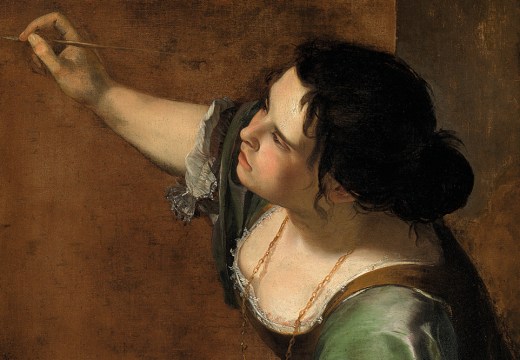
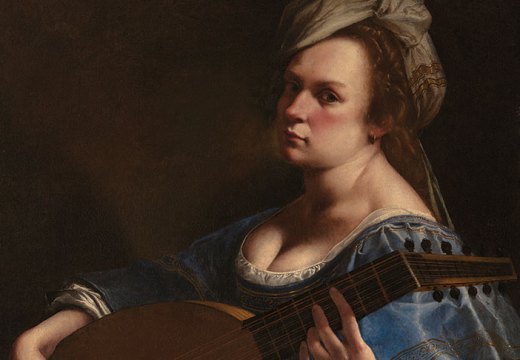
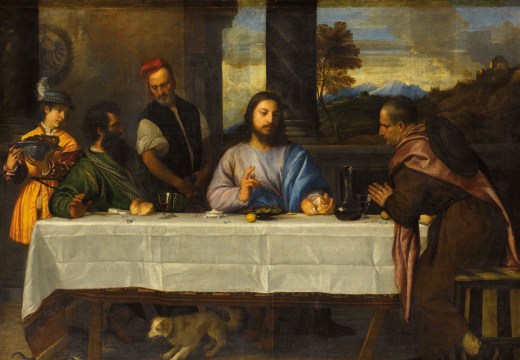









![Masterpiece [Re]discovery 2022. Photo: Ben Fisher Photography, courtesy of Masterpiece London](http://www.apollo-magazine.com/wp-content/uploads/2022/07/MPL2022_4263.jpg)
It’s time for the government of London to return to its rightful home